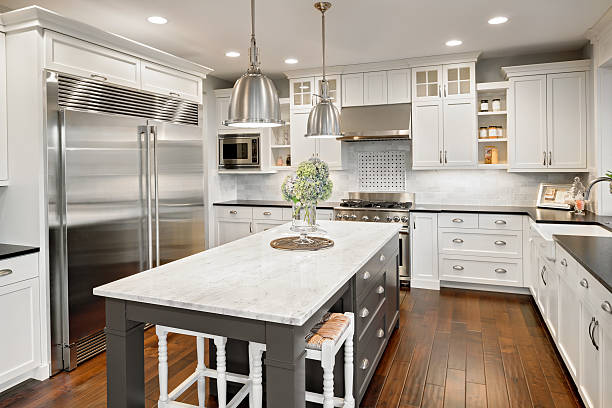6 Methods to Determine if a Granite Countertop is Sealed
Granite kitchen countertops are currently more popular than they've ever been among home remodeling enthusiasts. Aside from being a natural stone that grows over time, granite is also an extremely durable, scratch- and heat-resistant material, making it the material of choice for kitchen countertops in almost every home. Numerous individuals have started utilizing granite because it is simple to clean and resistant to stains. Additionally, granite is available in a variety of hues and patterns. It is not surprising that granite has become one of the most popular materials for home remodeling projects, given its resilience and aesthetic appeal.
However, granite can become damaged and scarred without proper upkeep. Granite, unlike typical tiles, requires care. Sealing the stone is a crucial stage in the maintenance of granite. However, what is a granite seal and is it required? In this blog post, we will attempt to explain what a granite seal is, why it is significant, how to identify if granite is sealed, and how to seal it if necessary. Stay careful and enjoy your remodeling!
Describe a Granite Seal
Granite seals, sometimes known as "granite impregnators," are clear, protective coatings that aid with stain and scratch resistance. There are both water-based and solvent-based granite sealers available. However, water-based sealants may require more frequent reapplication than solvent-based sealants. Due to their potent fumes, solvent-based sealants should be used with caution, despite providing great protection against stains and scratches.
This resin-like substance is distributed throughout the granite and serves as its covering. After a considerable amount of time, the resin is absorbed into the pores of the granite, making it resistant to stains and grime, so preserving the granite's appearance for many years. Additionally, granite sealer repels water and other substances, making spills simple to clean up. When utilizing granite as a kitchen countertop, it is essential to ensure that it is properly sealed before and after installation.
Sealing Granites: Is It Necessary?
Granite is a sturdy material, although it is not completely impervious to damage. Sealing your granite surfaces on a regular basis is one of the most critical things you can do to safeguard them.
Sealer for granite creates a barrier that repels water, oil, and other substances that can cause stains, discoloration, and dulling. Without this barrier, liquids can permeate the granite's pores and cause irreversible discoloration. In addition, unsealed granite is more prone to scratches and chips since the sealer prevents water, oil, and other liquids from damaging the granite. These liquids can cause granite to crack or chip if they seep into the granite. Additionally, granite that is not sealed is more prone to store bacteria and other pollutants. By sealing granite surfaces, you may preserve their appearance for many years.
Therefore, sealing granite is necessary to protect your investment. There are a variety of granite sealers on the market, so it is crucial to select one that meets your requirements.
If you are uncertain as to whether or not your granite is sealed, we have outlined six ways to determine whether or not your granite is sealed.
How to Identify a Sealed Granite?
As mentioned previously, sealing granite is necessary to preserve its beauty throughout time.
Sealing protects stone against stains and makes it simpler to clean. The color and texture of granite that has been sealed will be uniform throughout. If you are unsure whether or not your granite is sealed, you may do a few basic tests at home.
1. Search for a Color Change in the Granite
If the granite appears darker or more reflective than normal, it has likely been sealed. You may also spray a few droplets of water onto the granite's surface. Unsealed granite readily absorbs water, whereas sealed granite changes color when wet. Unsealed granite will have natural color variations, however sealed granite will have more uniform hue.
2. Feel the Granite's Surface
First, wipe the granite's surface with a moist towel. The granite is sealed if water beads up and does not penetrate the surface. Additionally, if the granite's surface is smooth and slippery, it has likely been sealed. Unsealed granite will have a more porous surface, making it more absorbent and abrasive.
3. Place a Drop of Water on the Granite's Surface
Water is an effective indicator of whether or not a granite is sealed, as water will discolor unsealed granites. If water beads up and remains on the granite's surface, it has been sealed. The granite has not been sealed if it absorbs water.

4. Test for Granite Sealant Residue With a White Rag
Rub a white cloth down the granite's surface. If there are any black streaks on the rag, this shows that the granite has sealant residue.
5. Test Iodine for Granite Staining
Place a drop of iodine on the granite's surface. If the iodine is absorbed by the granite, it is not sealed and consequently vulnerable to discoloration.
6. If Uncertain, Consult a Professional Granite Installer
You can always visit a professional stone repair firm or stone fabricator if you are unsure whether or not your granite has been sealed.
Do Granites Require Resealing?
Granite is a magnificent addition to any home, but it requires maintenance to remain in pristine condition. Depending on the type of granite you have and your cleaning routine, it may be necessary to reseal your countertops every six months to two years. Using the above-mentioned seal tests, you may determine if your granite needs to be resealed.
Numerous granite sealants are available at most hardware stores.
Some sealants require regular reapplication, while others might endure for years. When resealing granite tiles, be sure to choose a sealant formulated exclusively for stone. Applying the incorrect type of sealant can harm granite and void any applicable warranties.
How to seal granite
If you feel the need to reseal your granite countertops, a variety of granite sealants are available on the market. However, you must select a sealer of the highest quality, since using the incorrect or poor product may cause more harm than good.
If you've selected the greatest product on the market, here's how to seal it for many years.
1. Select the Correct Granite Sealer
There are numerous varieties of granite sealers on the market, so it is essential to select one that is created specifically for granite. Granite is a porous stone; therefore, it is essential to select a sealant that can penetrate the surface and fill the pores.
2. Clean the Granite Countertop's Surface
Before applying granite sealer, it is necessary to clean the granite's surface. Remove any dirt or debris from the surface using a light soap and warm water. Be sure to thoroughly rinse off the soap and allow the granite to dry before continue.
3. Coat the Granite with the Sealer
Once the granite is clean and dry, the granite sealer can be applied. Apply a little amount of sealant on a clean cloth and rub it in a circular motion into the granite's surface.
Be sure to uniformly cover the entire surface.
4. Permit the Sealer for Granite to Dry
After applying the granite sealer, you must allow it to cure completely. This could take anywhere between 30 minutes and 24 hours, depending on the type of sealant used. After the sealant has dried, you can use your granite countertops as usual.
5. As Necessary, Reapply the Granite Seal
To keep granite countertops protected from stains and other damage, it is necessary to reapply granite sealer every few months. If your countertops experience heavy use, you may need to reapply more regularly.
Sealing your granite is a simple technique that will protect it against stains and fading over time. Therefore, ensure that you perform it frequently for optimum results!

Common Errors in Granite Sealing
1. Not Examining the granite First
One of the most frequent errors people make when sealing granite is not testing the stone first to determine if it requires sealing. It is essential to test granite countertops prior to sealing them. Some granites are more permeable than others, while others may not require sealing at all. To test your granite, you may either put a drop of water to the surface and observe if it forms beads or is absorbed into the stone as described above. Test the granite by putting a little amount of sealant to an inconspicuous place and wiping it off after a few minutes. If the sealer causes the granite to get darker, it is absorbent and must be sealed.
2. Application of Excessive Granite Sealer
In addition to applying an excessive amount of sealant to the granite, this is one of the most typical blunders made while sealing granites. When too much sealer is applied, it might leave a difficult-to-remove residue on the surface of the stone. Follow the instructions on the bottle of sealer and apply only a thin layer of sealer to the granite.
3. Failing to Allow the Granite Sealer to Dry
A second typical error when sealing granite is not allowing the sealant to dry completely before using the countertop. It takes time for the sealant to permeate the granite and build a protective barrier. If you use the countertop before the sealer has dried, its effectiveness will be diminished.
4. Not Regularly Reapplying Granite Sealer
One of the worst mistakes individuals make is failing to reapply sealant frequently. Granite must be resealed every six to twelve months to retain its resistance against stains and scratches.
5. Using a Granite Sealer of Poor Quality
Using a sealer of lesser quality is another typical error made while sealing granite.
Sealants of inferior quality may not provide appropriate protection against stains and scratches and may require more frequent application. It is essential to use a high-quality sealant that is formulated exclusively for granite.
6. Not Immediately Cleaning Up Spills on Granite
Another typical mistake people make when sealing granite is not clearing up spills immediately. When liquids are permitted to remain on the surface of stone, they can permeate the pores and form stains. It is essential to mop up spills immediately in order to prevent stains.
Sealing your granite is essential to maintaining it and keeping it appearing brand new for many years. You will preserve your countertops from stains, etching, and ordinary wear and tear by using a sealant. In addition to looking wonderful, your countertops will be easier to clean and maintain with less effort.
If you're interested to have more knowledge about this topic, feel free check this blog post from Denver Stone Plus.

